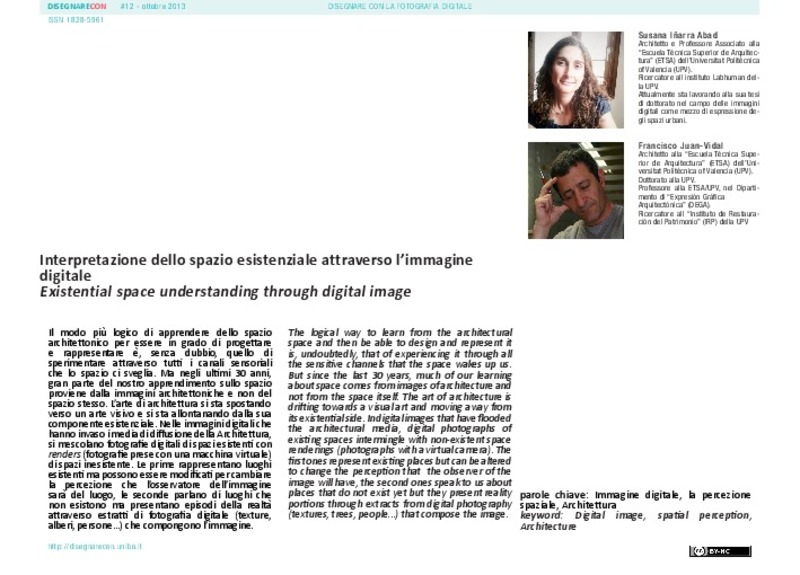JavaScript is disabled for your browser. Some features of this site may not work without it.
Buscar en RiuNet
Listar
Mi cuenta
Estadísticas
Ayuda RiuNet
Admin. UPV
Existential space understanding through digital image
Mostrar el registro sencillo del ítem
Ficheros en el ítem
| dc.contributor.author | Iñarra Abad, Susana
|
es_ES |
| dc.contributor.author | Juan Vidal, Francisco
|
es_ES |
| dc.date.accessioned | 2016-04-26T16:55:11Z | |
| dc.date.available | 2016-04-26T16:55:11Z | |
| dc.date.issued | 2013-10 | |
| dc.identifier.issn | 1828-5961 | |
| dc.identifier.uri | http://hdl.handle.net/10251/62990 | |
| dc.description.abstract | [EN] The logical way to learn from the architectural space and then be able to design and represent it is, undoubtedly, that of experiencing it through all the sensitive channels that the space wakes up us. But since the last 30 years, much of our learning about space comes from images of architecture and not from the space itself. The art of architecture is drifting towards a visual art and moving away from its existential side. In digital images that have flooded the architectural media, digital photographs of existing spaces intermingle with non-existent space renderings (photographs with a virtual camera). The first ones represent existing places but can be altered to change the perception that the observer of the image will have, the second ones speak to us about places that do not exist yet but they present reality portions through extracts from digital photography (textures, trees, people...) that compose the image. | es_ES |
| dc.description.abstract | [IT] Il modo più logico di apprendere dello spazio architettonico per essere in grado di progettare e rappresentare è, senza dubbio, quello di sperimentare attraverso tutti i canali sensoriali che lo spazio ci sveglia. Ma negli ultimi 30 anni, gran parte del nostro apprendimento sullo spazio proviene dalla immagini architettoniche e non del spazio stesso. L’arte di architettura si sta spostando verso un arte visivo e si sta allontanando dalla sua componente esistenziale. Nelle immagini digitali che hanno invaso i media di diffusione della Architettura, si mescolano fotografie digitali di spazi esistenti con renders (fotografie prese con una macchina virtuale) di spazi inesistente. Le prime rappresentano luoghi esistenti ma possono essere modificati per cambiare la percezione che l’osservatore dell’immagine sarà del luogo, le seconde parlano di luoghi che non esistono ma presentano episodi della realtà attraverso estratti di fotografia digitale (texture, alberi, persone...) che compongono l’immagine. | es_ES |
| dc.language | Español | es_ES |
| dc.publisher | University of Bologna | es_ES |
| dc.relation.ispartof | DisegnareCon | es_ES |
| dc.rights | Reconocimiento - No comercial (by-nc) | es_ES |
| dc.subject | Digital image | es_ES |
| dc.subject | Spatial perception | es_ES |
| dc.subject | Architecture | es_ES |
| dc.subject | Immagine digitale | es_ES |
| dc.subject | Percezione spaziale | es_ES |
| dc.subject | Architettura | es_ES |
| dc.subject.classification | EXPRESION GRAFICA ARQUITECTONICA | es_ES |
| dc.title | Existential space understanding through digital image | es_ES |
| dc.title.alternative | Interpretazione dello spazio esistenziale attraverso l'immagine digitale | es_ES |
| dc.type | Artículo | es_ES |
| dc.identifier.doi | 10.6092/issn.1828-5961/3855 | |
| dc.rights.accessRights | Abierto | es_ES |
| dc.contributor.affiliation | Universitat Politècnica de València. Departamento de Expresión Gráfica Arquitectónica - Departament d'Expressió Gràfica Arquitectònica | es_ES |
| dc.description.bibliographicCitation | Iñarra Abad, S.; Juan Vidal, F. (2013). Existential space understanding through digital image. DisegnareCon. 6(12):XI-1-XI-6. doi:10.6092/issn.1828-5961/3855 | es_ES |
| dc.description.accrualMethod | S | es_ES |
| dc.relation.publisherversion | http://dx.doi.org/10.6092/issn.1828-5961/3855 | es_ES |
| dc.description.upvformatpinicio | XI-1 | es_ES |
| dc.description.upvformatpfin | XI-6 | es_ES |
| dc.type.version | info:eu-repo/semantics/publishedVersion | es_ES |
| dc.description.volume | 6 | es_ES |
| dc.description.issue | 12 | es_ES |
| dc.relation.senia | 257180 | es_ES |








